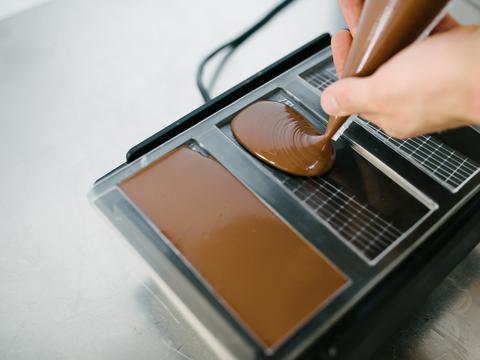Our distinct chocolate is created by transforming direct trade cocoa beans and simple organic ingredients into sweet, sophisticated flavors. Just as charm schools "refine" their students, we source cocoa beans from around the world, and carefully "refine" them into "polished", non-dairy, vegan chocolate.
Cocoa Bean Sourcing:

Great chocolate starts with great cacao.
Much like wine grapes, the same bean grown in different locations will develop completely different flavors. We, as chocolate makers, are then given the unique pleasure of seeking out unusual cocoa beans, and working with them to highlight each and every one of their amazing differences.
Believe it or not, more than 30 developing countries produce cocoa beans. However, of the 9 billion pounds produced in 2013, it’s estimated that less than 0.5% of the world’s production is certified organic. (International Cocoa Organization http://www.icco.org/) As a strong believer in fair wages for farmers and keeping our plants free of heavy metals, chemicals and pesticides, we only source cacao that meets the highest standards.


Sorting:

Before the beans can be roasted, each burlap bag is opened and sorted. In a slow and arduous process, we hand select only the plump properly fermented beans.
Without this attention to detail, the final flavor of the chocolate could be compromised by sub-par beans, or even worse, the same beans (and the occasional stone) could damage our equipment during roasting or grinding.

Roasting:

Each bean arrives at the factory with it’s own blend of natural flavors (ie: acidic, bitter, fruity, chocolatey..etc) given to it by its genetics, growing conditions, fermentation and drying methods. In this critical step, the application of heat gently coaxes the cocoa bean to reach its full flavor potential. Additionally, roasting helps to separate the paper-thin husk from the more desirable portion of the bean, and reduce the beans' moisture content, giving the finished chocolate a much-desired long shelf life.
Of course, for all the science involved, there is a great art to properly roasting cacao. The time and temperature may vary greatly from bean to bean, so every roast is performed by hand, carefully tasting as time progresses and ensuring the most dynamic flavor from each harvest.
Winnowing:
Once the beans have been removed from the roaster and rapidly cooled, the next step is to remove their paper thin husks. First, we crush the bean, breaking it into fragments of husk and small shards, called nibs. The husk is much lighter than the nibs, so a carefully directed air stream is used to blow the husk away, leaving the clean nib behind.


Pictured above is the traditional method of tossing the crushed, roasted beans into the air and allowing the wind to carry the lighter shells away.
Mixing / Grinding / Conching
In this stage, the solid nibs are ground to a smooth paste and start to resemble the chocolate we all know and love. The process of reducing the particle size of the nibs and sugar mixture is known as "refining".


To achieve the proper texture, the nibs are poured into a rotating drum, with huge granite rollers. This machine is called a Melangeur.

Initially, the enormous weight of the granite wheels and the friction generated from their rotation crushes the nibs into a smooth, flowing paste. Sugar, and any additional flavorings (ie: coconut for our Coconut Milk Chocolate) are added and join the nibs as they blend and continue to be ground smoother and smoother.
Also during this process, the intense agitation and generated heat causes the fat within the now ground cocoa beans (known as cocoa butter) to evenly distribute itself within the chocolate, and the more volatile acids to evaporate. This both rounds the chocolate's flavor, and creates a silky-smooth mouthfeel. This portion of the process is known as Conching.
Tempering:

The last step in the journey from cocoa bean to bar, Tempering is a method of heating, cooling, and agitating chocolate to cause it to set in it's most stable form. When cast against a smooth surface (ie: using a mould), the chocolate will appear firm, glossy, and have it's signature snap when broken.

